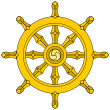
Back সুবর্ণভূমি Bengali/Bangla Suvarnabhumi German Suvarnabhumi English Suvarnabhumi Spanish Suvarnabhumi French सुवर्णभूमि Hindi スワンナプーム Japanese សុវណ្ណភូមិ Cambodian സുവർണഭൂമി Malayalam သုဝဏ္ဏဘုံ MNW
| Bagian dari seri tentang |
| Buddhisme |
|---|
 |

Suvarṇabhūmi (Sanskrit: स्वर्णभूमि; Pali: Suvaṇṇabhumī; bahasa Burma: သုဝဏ္ဏဘူမိ, [θṵwʊ̀ɴna̰bùmḭ]; bahasa Khmer: សុវណ្ណភូមិ, Sovannaphoum; bahasa Thai: สุวรรณภูมิ, RTGS: Suwannaphum) adalah nama sebuah negeri yang disebut dalam banyak sumber kuno seperti Mahavamsa,[1] beberapa cerita dari Jataka,[2][3] dan Milinda Panha.[4]
Suvaṇṇabhumī berarti "Negeri Emas" dan mungkin sebuah wilayah bernama Aurea Regio di "India di luar Gangga" dari Ptolemaeus, yang juga disebut sebagai Semenanjung Emas. Periplus dari Laut Erythraean mengacu kepada Negeri Emas, Chryse, dan menggambarkannya sebagai "sebuah pulau di samudera, di ujung terjauh ke arah timur dari dunia berpenghuni, terletak di bawah matahari terbit itu sendiri, yang disebut Chryse...Melewati negeri ini...di sana terdapat sebuah kota bagian dalam yang sangat besar yang dinamakan Thina".[5] Dionysius Periegetes menyebutkan: "Pulau Chryse (Emas), terletak di bagian paling terbit dari sang Surya".[6] Avienus mengacu kepada Insula Aurea (Pulau Emas) terletak di mana "lautan Scythian menjadi tempat terbitnya sang fajar".[7] Josephus berbicara tentang "Aurea Chersonesus", yang ia samakan dengan Ophir menurut Alkitab, dimana kapal-kapal dari Tyre dan Israel membawa pulang emas untuk Kuil Yerusalem.[8] Kota Thina digambarkan dalam Geografi Ptolemaeus sebagai ibu kota dari negeri di pantai timur dari Magnus Sinus (Teluk Thailand). Ada yang berspekulasi bahwa negeri ini mengacu kepada Kerajaan Funan. Pelabuhan utama Funan adalah Cattigara Sinarum statio (Kattigara pelabuhan dari Sinae).[9]
- ^ “To Suvarnabhumi he [Moggaliputta] sent Sona and Uttara”; Mahānāma, The Mahāvaṃsa, or, The Great Chronicle of Ceylon, translated into English by Wilhelm Geiger, assisted by Mabel Haynes Bode, with an addendum by G.C. Mendis, London, Luzac & Co. for the Pali Text Society, 1964, Chapter XII, “The Converting of Different Countries”, p.86.
- ^ Sussondi-Jātaka, Sankha-Jātaka, Mahājanaka-Jātaka, in Edward B. Cowell (ed.), The Jātaka: or Stories of the Buddha's Former Births, London, Cambridge University Press, 1897; reprinted Pali Text Society, dist. by Routledge & Kegan Paul, 1969, Vol. III, p.124; Vol. IV, p.10; Vol. VI, p.22
- ^ J. S. Speyer, The Jatakamala or Garland of Birth-Stories of Aryasura, Sacred Books of the Buddhists, Vol. I, London, Henry Frowde, 1895; reprint: Delhi, Motilal Banarsidass, 1982, No.XIV, Supâragajâtaka, pp.453-462.
- ^ R.K. Dube, “Southeast Asia as the Indian El-Dorado”, in Chattopadhyaya, D. P. and Project of History of Indian Science, Philosophy, and Culture (eds.), History of Science, Philosophy and Culture in Indian Civilization, New Delhi, Oxford University Press, 1999, Vol.1, Pt.3, C.G. Pande (ed.), India's Interaction with Southeast Asia, Chapter 6, pp.87-109.
- ^ Lionel Casson (ed.), Periplus of the Erythraean Sea, Princeton University Press, 1989, p.91.
- ^ Dionysios Oecumenis Periegetes (Orbis Descriptio), lines 589-90; Dionysii Orbis Terrae Descriptio
- ^ Rufius Festus Avienus, Descriptio orbis terrae, III, v.750-779.Descriptio orbis terrae
- ^ "Solomon gave this command: That they should go along with his own stewards to the land that was of old called Ophir, but now the Aurea Chersonesus, which belongs to India, to fetch him gold."; Antiquities, 8:6:4.
- ^ George Coedès, review of Paul Wheatley, The Golden Khersonese (Kuala Lumpur, 1961), in T'oung Pao 通報, vol.49, parts 4/5, 1962, pp.433-439; Claudius Ptolemy, Geography, Book I, chapter 17, paragraph 4; Louis Malleret, L’Archéologie du Delta du Mékong, Tome Troisiéme, La culture du Fu-nan, Paris, 1962, chap.XXV, “Oc-Èo et Kattigara”, pp.421-54; "Mr Caverhill seems very fairly to have proved that the ancient Cattagara [sic] is the same with the present Ponteamass [Banteaymeas], and the modern city Cambodia [Phnom Penh] the ancient metropolis of Sinae, or Thina", The Gentleman’s Magazine, December 1768, "Epitome of Philosophical Transactions", vol.57, p.578; John Caverhill, “Some Attempts to ascertain the utmost Extent of the Knowledge of the Ancients in the East Indies”, Philosophical Transactions, vol.57, 1767, pp.155-174.